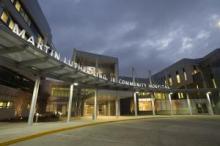MLK Hospital Finally Poised To Reopen

Is “Killer King” dead?
That is the sincere hope of the management of Martin Luther King Jr. Community Medical Center as it reopens in a matter of weeks.
The hospital was closed by the Los Angeles County Department of Health Services in August 2007 after a series of serious lapses in patient care. They included horribly botched surgeries, critically ill patients whose vital sign monitors were ignored by nurses and a woman left to die writhing on the floor of the emergency room as janitorial staff cleaned around her. The hospital also failed on a spectacular level during a federal inspection that led to the loss of its Medicare accreditation, with staff apparently unable to locate or mix medicines, sterilize instruments or properly perform other mundane tasks.
The hospital received two administrative penalties from the California Department of Public Health in its last months of operation, including a citation involving a neurology patient who waited in the emergency department for several days without receiving a proper evaluation or transfer to another facility, records show.
At the time the decision was made to close the hospital, then Los Angeles County Supervisor Yvonne Braithwaite Burke remarked of the staff, “I don't know how you'd be able to tell how stupid some of these people are.”
The reincarnated King hospital, located at 120th Street and Compton Avenue in South Los Angeles, will operate on a much humbler scale. It will have just 131 beds, compared to the more than 460 its predecessor had at its peak. Gone is the trauma center, the medical residency program, the neonatal intensive care and invasive cardiology units. Much of the hospital will reside in an eight-story tower that had been built as a trauma unit for the old hospital but never used.
We’re going to be a general acute care community hospital, we’re not going to have the high-end services,” said Jim Lott, King’s chief strategy officer. “The entire delivery model is going to be different. We’re not going to give the keys to a teaching institution and we’re not going to have an open door for clinical privileges.”
Many of the services at the reincarnated King will be provided on contract from large hospitalist and emergency medicine medical groups. They include Intercede Health, a Houston-based firm that will provide hospitalist and intensivist physicians, and VEP Healthcare, a Walnut Creek-based firm that will provide emergency room physicians. The UCLA Health system will provide radiology and urology services. And Kaiser Permanente’s Southern California division is serving as a “mentor” to King’s management team, providing advice on how to proceed. Georgina Garcia, who runs Kaiser’s West Los Angeles Medical Center, sits on King’s board of directors.
“We feel that this is the best way to get a handle on quality and to avoid problems that the old hospital experienced before,” Lott said.
Pretty much everything associated with the old hospital is gone. Buildings in and around the hospital have been extensively redeveloped.
“It’s very modern and it has some pretty impressive curb appeal,” said Jennifer Bayer, vice president of external relations for the Hospital Association of Southern California.
Lott said King’s new licensure should be completed and issued by the CDPH by May.
After that, the hospital will need admit a minimum of 30 patients and discharge at least one of them before it can then earn accreditation from either the Joint Commission or the Centers for Medicare & Medicaid Services. That is required before it can begin receiving payments for services.
As a result, King’s new emergency room will be staffed, but will not be officially accepting patients for about 60 days until after it opens, according to Lott.
Scaled back or not, a reopened King is needed in the community, which experienced a significant gap in acute care services and led to far heavier traffic at nearby hospitals.
According to Bayer, California as a whole has two hospital beds for every 1,000 residents. In King’s service area, there are 0.9 beds for every resident.
“It’s really, really under-bedded, and bringing a new facility on line is obviously going to be welcomed,” she said. “We’re not seeing a lot of hospitals open up in this state, and it’s definitely a new day.”
Lott, whose career in the Southern California hospital sector dates back more than 40 years, is perhaps the closest thing to institutional memory King currently possesses. He performed a management internship at the old King hospital not long after it opened its doors in 1972 when it was a great source of pride for the South Los Angeles area. More than three decades later he served on an advisory committee when problems had been plaguing the institution for some 20 years and a last-ditch effort was made to keep its doors open.
Lott said he mentioned during an orientation session of new employees the “Killer King” sobriquet the hospital earned in the 1980s and 90s as reports of poor patient care began to multiply. It was a necessary part of teaching them the hospital’s history, he added.
“‘You need to hear this term, and know what we succumbed to,’” Lott said he told the new employees. “But then I never want to hear the term or ever have to use it again.”






